
THE PLATES
In most cases, it seems the original images were cropped for the book. Where possible a link has been provided back to the Mitchell library site to their listing and the original uncropped image. The Mitchell Library negative numbers for the Holtermann Collection are given in brackets at the end of each plate note.
If a link has been provided, click on the bracketted image number at the bottom of the plates. It is definitely worth seeing the original print in the uncropped format - it usually has much more detail. The text for each plate is as written by Keast Burke in 1973. Please also check the Mitchell Library site and the link as the Library is constantly updating their information on these images.
The following plates are scanned copies of the pages from Keast Burke's 1973 book. Copies of these plates are not available from photo-web. Copies of these images can be purchased from the original negatives in the Mitchell Library Sydney.
HILL END
People and Homes
The majority of the houses were constructed at little cost from materials close at hand using the familiar English method of wattle (or lath) and daub. The various stages of construction can be seen in this section. The scheme called for a stout system of verticals capable of supposing a framework of either round or split saplings to which were applied successive rows of clay mixed with cham or dried horse manure. When the wails were covered with the mixture both inside and out, they were deeply incised in a criss-cross pattern to ensure good adherence for the trowelled plaster surfacing which followed.
Then came the dishing coat of pipe-clay and tallow and last of all whitelime-wash. The artistically inclined added tints of light blue or pink, while the more Ambitious ruled up the job with vertical and horizontal lines to resemble masonry or brickwork. The interior was surfaced with old newspapers or hessian ('sugar-bag') plus a few coats of whitewash. Bark was normally used for roofing and sometimes also for walls, particularly in Gulgong. The bark of the stringy-bark tree was favoured for its neat appearance and easy handling. Less desirable was box-bark which was rather unattractive and did not lie very flat.

1. One of the most delightful of the cottage pictures. Every element seems to have been waiting for Beaufoy Merlin - the gentle sloping ground, the suggestion of fence and distant landscape, the decorative sapling, the neatly-fabricated iron chimney, the bright new whitewash. The visitors are well balanced with the mother and young baby. (18772)

2. This charming family group demonstrates the quality of Merlin's posing and composition. In a cascading frame of banksia rose, the figures are arranged in a classical pyramid form for unity and stability, the hands are placed with special care, and the right-looking profiles add subtlety. A photographic tour-do-force in any age. (70173)

3 ‘Granny's Visitor' was thus titled ever since the negative was first printed. Granny is seen as a calm serene figure whose shawl and bombazine contrasts with the visitor's modish jacket, bonnet and parasol. Granny is the prototype for Henry Lawson's poem (Black Bonnet'. (18685)

4. The photographer was always alert for any element which would lend interest and story-telling value to the finished picture - hence the inclusion of the rocking horse. (18699)

5.* The early villagers were proud of their gardens and this study skilfully interprets this pride. As a composition, the brightly-lit path framed in dark greenery, leads the eye to the mother, with her child, in her favourite rocking-chair. (70145)

6. The strength of the horse with top-hatted rider contrasts with the gentler grouping of the mother with small child on her knee and the elder girl busy with her hoe. Details of the dresses are clearly rendered. please see the full image > (18682)

7. Obviously a man of substance, demonstrated in his stance and his possessions. Features of the house are the imitation stone wall dish, neat railing and tidy window curtains. (18751)

8. The minister's young wife looks happily towards a new life with her manly husband in her trim well-built home. (18528)

9. Truly a photographer's photograph. Consider the essentials - the interesting shadow shapes, the new and well-made door, the positioning of the figures, and the parasol placed to break the line of the door-jamb. The details of the costumes are clearly recorded. (18607)

10.* This well-lit figure, shown against the dark shadow of the door has something of a cameo quality.
A picture of perfect harmony - the weathered shingles, the carefully-sealed slab wails, the sturdy steps, the ever-popular banksia climbing rose. (18672)

11.* A young wife smiles happily as she fingers her wedding ring. Her bodice is trimmed in a square yoke and her hair features forehead kiss-curls. The home is of sawn weatherboards with roof of box-bark. (18727)

12. Here Merlin perceived the generation gap - and arranged the group accordingly. (70188)

13. One wonders how many plate coatings and exposures were necessary before perfect sharpness was obtained for all five (sitters', at least three of whom were likely to move at any instant. The harness still on the horse suggests the return of the father from work. (18649)

14. A sense of isolation is powerfully conveyed, with the single black-clad figure placed against closed door and windows, the bare cottage wall unrelieved by garden plot. (18505)

15. By posing this single figure on a crutch against the length of massive fence, Merlin has dramatised the men's present state of inactivity. It was he, doubtless, who in happier days made that fence, planned the unusual gate design and painstakingly trimmed the posts. (18503)

16. Some kind of verandah flooring remains to complete this well-built cottage in sandstock brick, perhaps from the new brickworks along Hill End Creek. The guttering has been trimmed a couple of feet short so that the rainwater will run directly into the cask. Of note is the women's costume with its voluminous skirt and frilled side panels. Above the man's head hangs a parrot cage. (18683)

17. Only a formal approach was possible with this four-square home, although the tree provided minor relief. The daub has been carefully scored to ensure adherence for the plaster surface before the finishing coat of pipe-clay and tallow. (18783)

18. Achievement and pride are in evidence everywhere: the well-built, shingle-roofed house, the picketed verandah (for the safety of the children), the fruit trees, the feeling of family affection. Leggings were generally worn and provided protection from snakes, savage dogs and undergrowth. (18647)

19. The lace curtains of the windows contrast amusingly with the manly figure his arms akimbo. (18731)

20. Every element points to financial stability – the well-finished wails in imitation stone, the large windows each of twelve panes, the iron roof with guttering and neatly established garden. The leaning figure could be the son of the house, while the standing figure in cummerbund could be a foreman or shaft-captain come to report progress. The head of the house enjoys the comfort of a chair and the companionship of his cherished kangaroo dog. These dogs were specially bred - according to Kaleski, from a cross of ‘grey hound, deer hound, and a little cattle dog' -for the sport of running down the largest ‘old-man' kangaroos. (18615)

21. Judging from the short-bundled shovel and the pile of daub, this cottage is actually under construction. Note the very neatly spaced wattles and the determined effort to make the roofing bark lie flat. (18675)

22. The father is proud of his young family and his new home, which he may well have built with his own hands - a regular bush capenter would not have been satisfied with the roof or the chimney. In the right hand window can be seen a face peeping out at the camera. (18587)

23. Anything handy would do for the wattles – here short pieces of sawmill offcuts have been used.(18609)

24. Another fine example of the posing of a woman, the sunhat pleasantly held in contrast with the men who are wearing theirs. (18663)

25. A delightful group. The smiling mother has a braided jacket and apron, whilst her bonnet exhibits a conceit of the time in the shape of bonnet strings. The elder daughter has a hand-knitted scarf, whilst her sister is warmly clad in a heavily-braided pelisse. The boy may have a whip in his left hand. (click here for more ...18533)

26. A lively impression of fresh morning sunlight, capturing the few minutes before the men with gear and waterbag set out for their claim. (click here for more...18674)

27. Hill End was not out of touch with city fashions - three modishly-dressed visitors have come to take tea and to admire the recently-finished house. (click here for more ..18664)

28.* Almost certainly one of the many Cornish families in Hill End. The identical costuming of the women - white tippets and black bombazine - suggested the idea of identical posing to the photographer. The windows are cutained in scallop-edged lace (click here for more ..18603)

29. The family is large and musical but rather self-conscious when faced by the camera. (70204)

30. Louis and Mary Beyers, with their elder daughters, Sylvia Helena and Gertrude Harriet, on the back verandah of their home in Clarke Street. (.. click here for more - 18742)

31 B. 0. Holtermann outside his cottage - the last photograph of him in Hill End, taken just before the move to St Leonards. (39890 - 43.11)
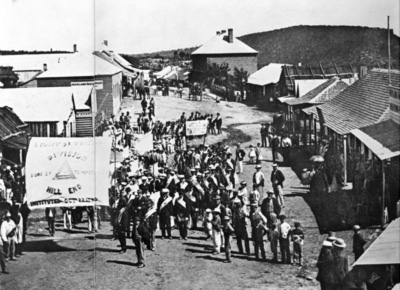
32 Central Clarke Street on the afternoon of I April 1872 -Temperance and Friendly Society members pause for the camera on their way to the ceremony of laying the foundation stone of the girls' wing addition to the Public School.
The view is looking northwards towards Bald Hill from the balcony of Patrick Coyle's Club House Hotel.
Some of the business premises are to be seen : immediately to the right are the Bank of N.S.W., Myer and Siefke (tobacconists, bowling saloon and shooting gallery) and Joseph Wythes's Reefers' Arms Hotel; the tall bark building is Jenkyns's (blacksmith and shoeing forge) ; next, the tiny first post once, G. C. Kirkpatrick (mining agent) and George Laroche (chemist) ; the trees mask Beyers's cottage on the German Town Road comer while beyond is the two-storey Australian Joint Stock Bank and J. K. Weir's Cricketer's Arms Hotel. (70215)
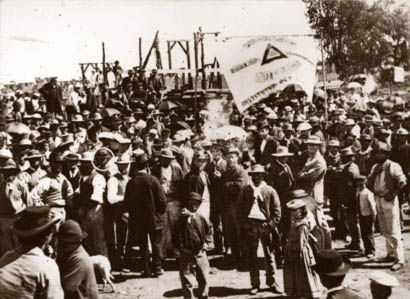
33 A few minutes later - a crowd of townspeople are photographed awaiting the actual ceremony which will be performed by Mrs R. 0. Kerr, with the police magistrate, Joseph Whitehead Lees in the chair. The stone can be seen today still in its place. The banner. (70214)
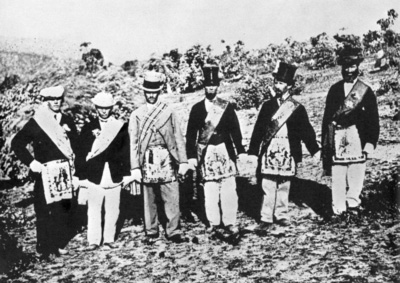
34 A group of members of the Committee of the Manchester Unity I.O.O.F. in regalia and gloves, with little angers linked. The regalia contained many metal threads and often weighed as much as seven pounds. Holtermann is seen second from the right. (70023)
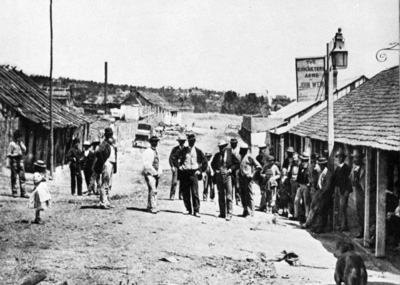
35 A very early picture of the south end of Clarke Street - perhaps one of the first to be taken here by the A. & A. It conveys a great deal of data: on the right there is to be seen a typical gathering outside J. K. Weir's Cricketer's Arms Hotel, one of the first to be established and one of the last to close its doors; next door is the first Telegraph Once, the single wire for which leads in from the tall pole opposite; just beyond the pole is the editorial once of the Hill End and Tambaroora Times and Goins's barber shop while Goins himself, in white coat and black tie, stands in the centre of the road.
Behind Goins's head is the A. & A. coating van, and, to the right of the telegraph post, there is a small group of three: from left to right, the van driver, Holtermann and Bayliss. In the distance is the new iron chimney stack of Pullen's battery, then in process of rebuilding with a larger fifteen-head battery. (70043)
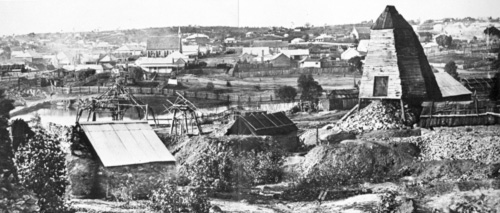
36 A general view of the town looking north from o1d workings near the east boundary of Scandinavian (west), taken in the spring of 1872. As one looks up Tambaroora Street (left of centre), much data is visible: for example, a tradesman is working on a window of the Presbyterian Church and some teams are delivering building materials to the site of Holtermann's shops.
The Royal Hotel, just to the right of the church, has been built. The other church, to the left of the enclosed shaft, was at this time the Methodist Church, while midway between the two is the original Church of England in Tnmbaroora Street, partly hidden by the roof of Henry Smart's Great Western Store. (18589)

37 A bullock-team outside the first Public School (1870). Part of the original Church of England can just be seen to the right, while beyond the school is the original Methodist Church of the some date. (70040)
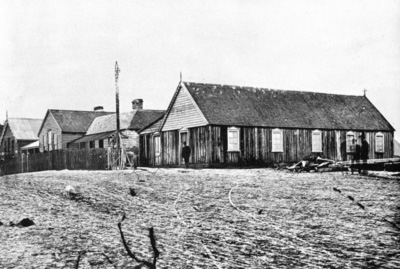
38 The same area photographed from a point a little further south and later in the year, as evidenced by the completion of the 1872 brick wing of the school. The whole of the first Church of England can now be studied in detail. (18692)
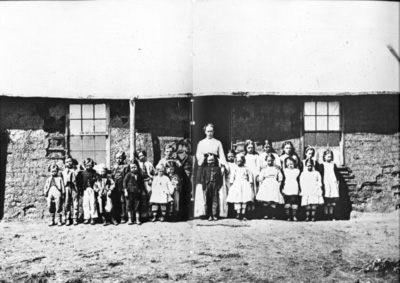
39 As well as the Public School, there were several private schools and at least one denominational school. Not one of these children has moved although an exposure time of from five to ten seconds was essential. (18860) not linked
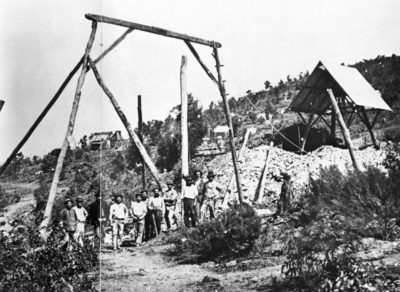
40 First stages in the erection of a whim to provide horse-power heisting for the new shaft (right) which has a roof of galvanized iron for protection against the elements. The average height above sea level is about 3000 ft. (18729)
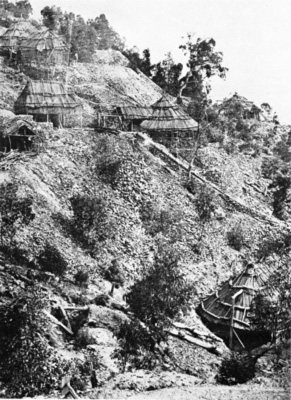
41 Whim and shaft houses along the western slope of Hawkins Hi11. Visitors were impressed by these pleasing examples of bush carpentry, and one correspondent wrote: the horse which works the whim is in every case sheltered from snow and rain by a very picturesque octagon building roofed to a point in bark . . . the make of these whims displays no mean proficiency in bush carpentry and the liberality with which they are supported by struts and braves is marvellous.' (70116)
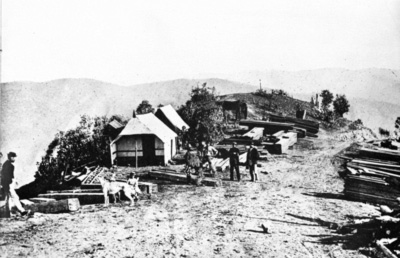
42 The scene at the end of Hawkins Hill, looking south across the gorge of the Turon river almost I500 ft. below. The knoll marked the Golden Crown claim while the cutting to the right shows the beginning of the original bridle track to the river - in fact a teem can be vaguely seen.
In the foreground are piles of timber on its way to the line of shafts down the steep slope to the west. By pack horse and raw hide bag the gold-bearing quartz had to be laboriously brought up these some steep slopes. (18774)
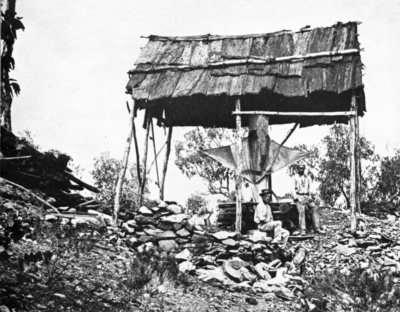
43 An initial stage in reef prospecting, with the shaft already provided with bark roof protection and a canvas wassail for ventilation. (70128)
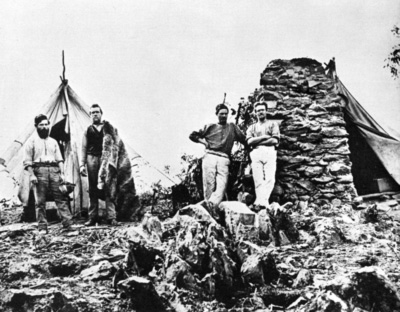
44 A typical syndicate of four men, with their tent on the left and cockhorse on the right. (18765)
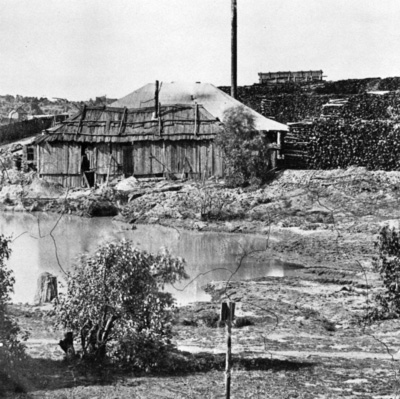
45 Old and new batteries at Pullen and Rawsthorne's, south end of Clarke Street; the bark structure contained the early five-stomper unit, while the galvanized iron building houses the new fifteen-head battery which was installed early in 1872. The heavy iron shoes of the stampers pounded noisily day and night - battery noise was a feature of Hill End life.
After the quartz had been crushed to a powder, it was washed over rows of copper plates covered with mercury, an element which has a great affinity for gold. The mercury was subsequently evaporated off (and recovered) in a heated crucible in which the gold remained. (70095)
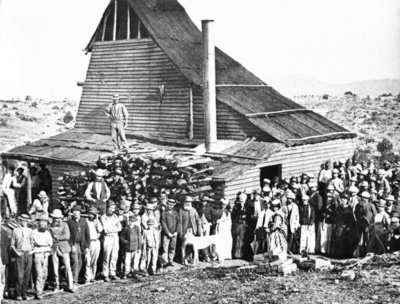
46 Opening day, in late March or early April, of the first power hoist on the Hill, at the Great Exhibition Co.'s claim. Hoist movements were controlled by the ‘knocker line' code, ‘one ring, stop; two rings, lower; three rings, haul up; four rings, man on the kibble' (a large iron bucket). (70226) no link
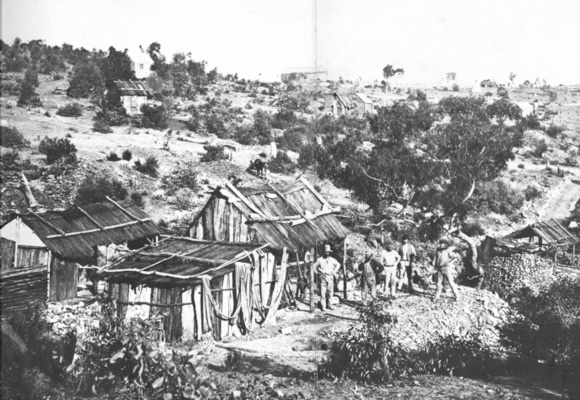
47 An attractive impression of shaft, outbuildings and members of the syndicate. The hexagonal-shaped article to the left of the group is a candle-lump a rare inclusion in the series. Incidentally this reproduction was made directly from one of the original century-old 10” by 12” albumen prints to demonstrate the excellent technical quality that was obtainable. (49.33) no link
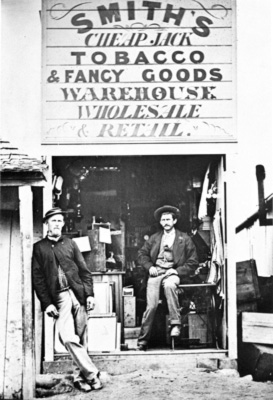
48 Clarke Street's smallest enterprise - a wholesale and retail warehouse' on an eight-foot frontage. (18709)
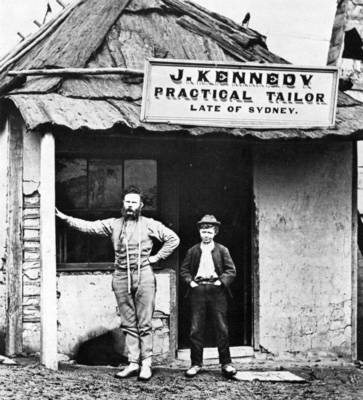
49 Next door to S. Hosie's store, which can just be seen under construction, was to be found Sydney tailor J. Kennedy and sometimes his self-confident young nephew. These were the days when tailoring was sewn ‘on the knee' and so the wrinkles may be considered pardonable. (18643)
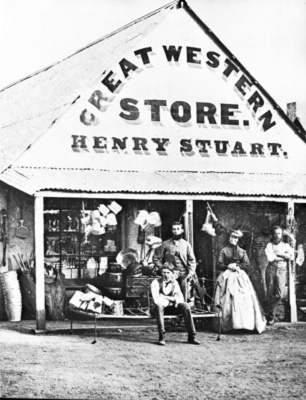
50 Still standing in Tambaroora Street, at the Havilah Street corner, are the premises which once housed Henry Stuart's Great Western Store; his premises stocked a large range of merchandise from colonial griddles (left), ovens and coffee pots to whitewash brushes. (70036)
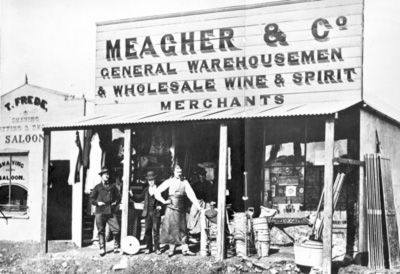
51 Young John Meagher exhibits well-merited pride in his fine new store (1 expensive galvanized iron) and its wide range of hardware and general commodities - all of which, incidentally, had to be carried indoors at closing time before the heavy wooden shutters (right) were put up. He was not to know that he would lose everything in the depressed year of 1874 - when a 'suspicious' fire spread from a nearby hotel - only to start up again in Bathurst and eventually establish a chain of country stores. (18656)
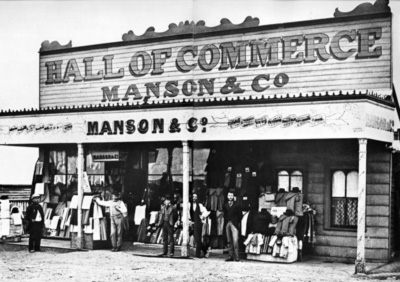
52 Entering Clarke Street from the north, the visitor first saw on his right Manson and Co.'s large soft-goods store, with the prices of most items clearly set forth. Donald Manson would probably be the individual standing in the entrance. (18724)

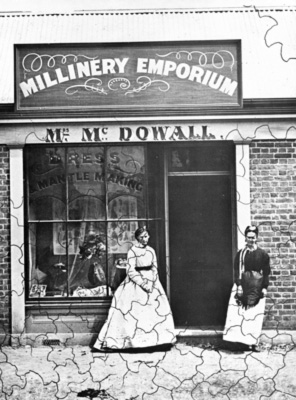
53/54 In 1872 Holtermann built two blocks of shops (still standing) in the Tambaroora Street-short Street area, and two of the first tenants are here recorded (see next plate). The strange jigsaw markings are caused by cracked varnish and have been intentionally left unretouched. The first picture shows chemist W. A. Bray (right) and Holtermann; the window display contains such familiar items as Macassar Oil and Chlorodyne. Bray also had a fine collection of chemists' display jars and a magnificent street light, topped by a pestle and mortar. The next reproduction shows Mrs McDowall and her young assistant, and in the window some examples of her millinery. (18820 / 18835)

55 P. McGinley's tobacco depot was in Clarke Street, four or five doors north of Kennedy the tailor. His fancy goods' included an extensive range of accordions, a popular instrument outback. Along the right margin is portion of the canvas studio of Pyke and Moss, portrait photographers. (18636)
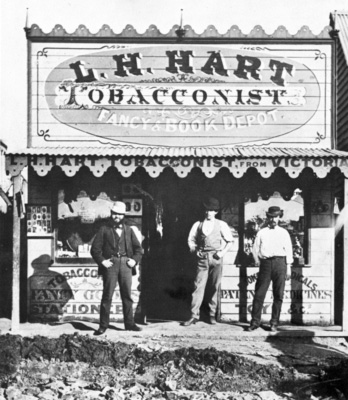
56 Close by in the same street were the premises of L. H. Hart, ‘tobacconist from Victoria'. His establishment also stocked books and fancy goods, the latter including skipping ropes and patent medicines, as well as finding room for a professional photographer and a solicitor and attorney from Sydney, Robert D. Bailey, who is seen on the left. (18735)
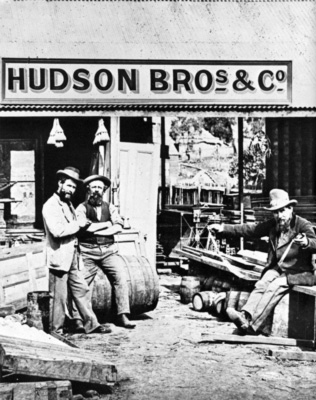
57 One of the finest genre studies in the series is this group of the three original Hudson Brothers, set against a background of their stock of building materials in glorious disarray, just as they had been dumped of the bullock waggons which had brought them from the railhead. Included are such things as doors, galvanized roofing iron, kegs of nails, and turned wood sections. The figure on the right is holding a surveyor's chain, or rather tape, for the links of Edmund Gunter (1561-1626) had long ago gone out of use. (18793)
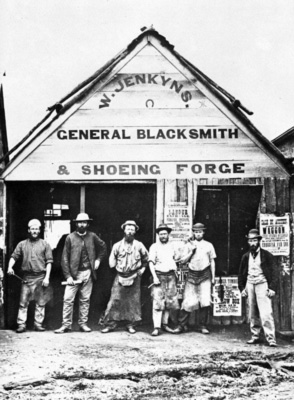
58 Jenkyns's shoeing forge stood in Clarke Street a few doors from German Town Road. The grouping is excellent, with Jenkyns in the doorway and next to him the caller of the moment, while his assistants, each with his own tool of trade, stand to either side. Slightly aloof, as beats a passer-by, is friend Holtermann. Jenkyns was apparently not superstitious as to the accepted placing of horseshoes. (18715)
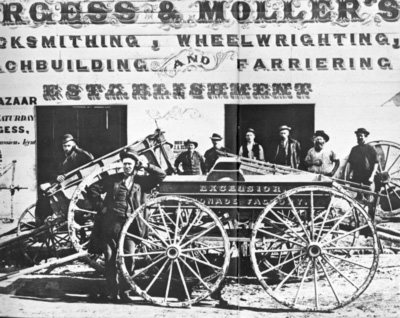
59 Burgess and Moller's coachbuilding shop in central Tambaroora Street provided the subject matter for a technically perfect photographic documentation – the well-posed partners (left), the lively sign-writing, the general feeling of activity. Its site was not far from the existing Presbyterian Church. (18678)

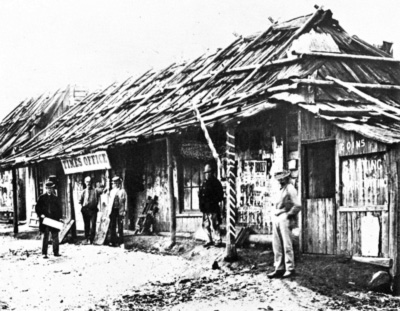
60/61 In view of the fact that very few copies of the local papers have been preserved it was exciting to locate photographs of both editorial premises : the Hill End Observer (1 Tambaroora Street just above Holtermann's shops) and the Hill End Times (which was at the south end of Clarke Street).
The Observer editor in shirt sleeves and white vest is clearly identified by the pen and inkwell in his left hand. The Times partners would be the figures near the signboard - one leaning against the post and the other holding a printer's galley. Thç lean-to on the right is occupied by Goins's barber shop and Goins himself is to be observed standing outside. (18832 / 70208)
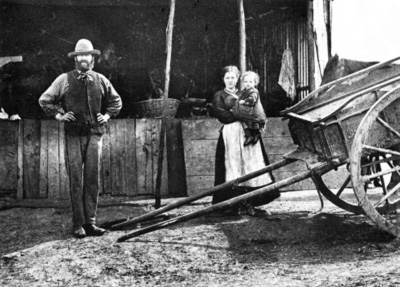
62 Greengrocer and general carrier - a study included for its posing reminiscent of Millais. (18747)
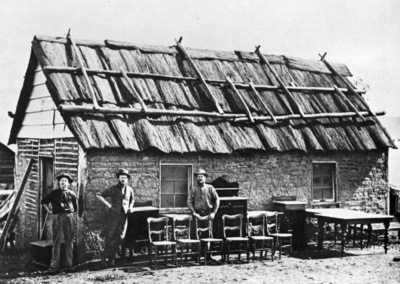
63 A cabinet maker displays the results of his craftsmanship. In the centre is T. Ackland, Tambaroora Street. (18679)
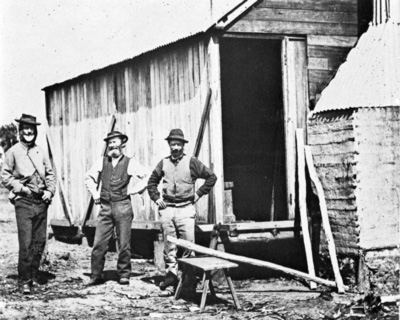
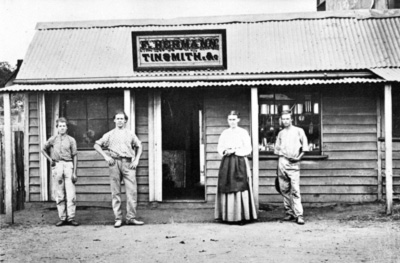
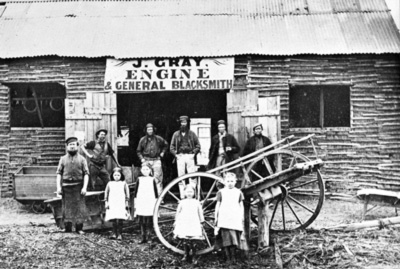
64/65/66 Fine groupings of three busy occupations - bush carpenters, tinsmiths, and engine blacksmith. One of the carpenters - or perhaps just a passer-by - appears to have suffered from a broken jaw and has his chin supported by bandage and bandana.
The tinsmith, F. Hermann, was just south of the part-seen two-storey Coyle's Club House Hotel, the first-floor balcony of which provided an excellent vantage point for general views of Clarke Street.
John Gray's smithy was towards the south end of Reef Street. A delightful grouping for a comparatively large number of spurts, along with a light dray of springless type. (18583 / 70056 / 18543)
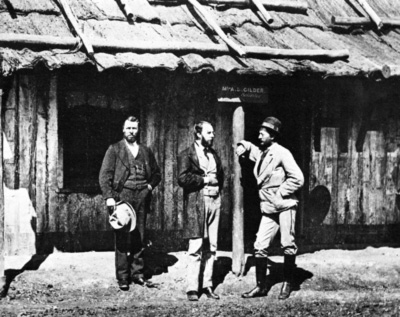
67 Solicitor Arthur Sherrington Gilder and two clients have stepped out into the sunshine for a moment. His legal once is of sturdy slab construction with the joints covered by strips of galvanized iron. The site has not been determined but his neighbour appears to be a hay and corn store. Profile portraits are rare in the Collection. (18509)
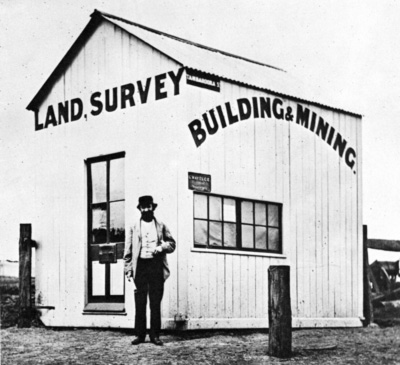
68 Civil Engineer C. Mayes appears to have been well able to handle a variety of responsibilities. His office has been prefabricated, differing in construction from any other structure on the field. It was the first building in Tambaroora Street (north end) - hence the street sign which is the only one recorded. The sturdy post provided protection from teamsters in a hurry. (18721)
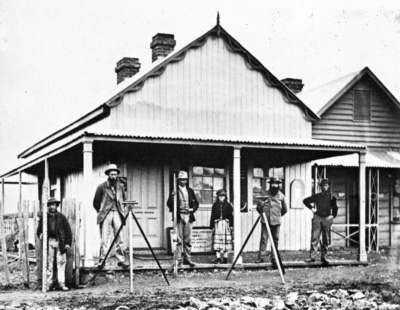
69 James Barrie, surveyor, sharebroker and commission agent, was also, according to the notice board near the door, local accountant for the Star of Hope Co. (as from 25 September 1872) and local representative for the A.M.P. Society (as from z7 March 1872).
He was photographed with his equipment and stag outside his once which was the last southward building in Tambaroora Street (see plate 36). The office still exists as a private house on another site nearby. (18501)
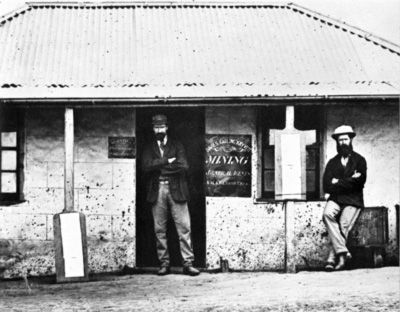
70 Office of the partnership of mining agents Davies, Garling and Keyvett. It advertised in the local press as having for sale (Leases and Shares in Leases at Hill End, Louisa Creek, Sofala, Wattle Flat, Box Ridge and Quartz Ridge'. (18708)
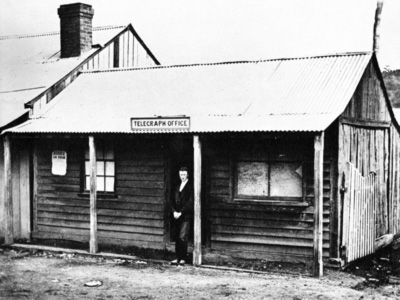
71 The first Telegraph Office was in lower Clarke Street between Weir's Cricketer's Arms and John E. Clyne's Tattersall's Hotel, portion of which can be seen to the left. The single telegraph line from Sydney was considerably overworked; it was reported that between the hours of 9 a.m. and 9 p.m. on one day - 22 April 1872 - 524 messages were handled of which I75 went through this office. (70213)
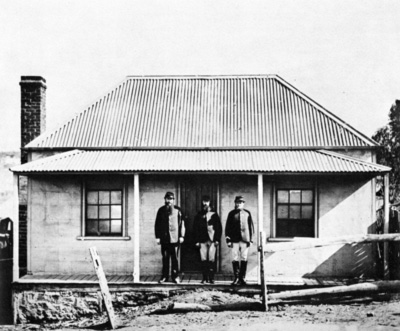
72 Hill End Police Station - Sgt. Mark Ford (left) with two troopers. (18693)
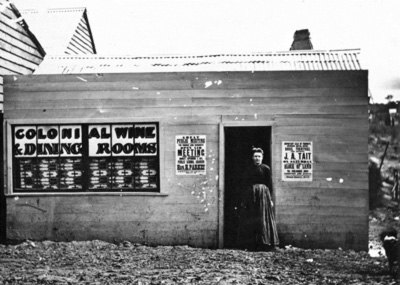
73 The Colonial Wine and Dining Rooms photograph proved to be an important one for two reasons – the inclusion of the Hon. Henry Parkes poster calling a meeting for 5 p.m., 2 September 1872, in the Public School grounds, and the fact that part of the building still remains, incorporated in the existing store and refreshment rooms, immediately opposite the Royal Hotel. (18630)
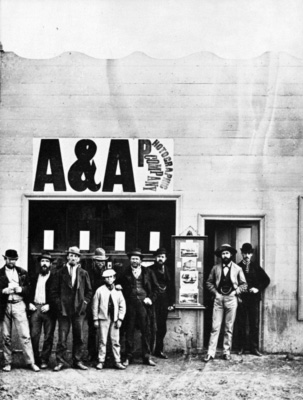
74 The studio of the A. & A. in Tambaroora Street in early April I 872. Charles Bayliss is seen in the doorway and behind him the studio operator and darkroom assistant; to the left of the framed photographs stands the driver of the caravan, who also probably did some coating, as he is usually seen with a spare dark-slide in his hand; the 1ad in white is often seen in the photographs and may be his son. Shortly afterwards, the vacant shop next door was occupied by the Hill End Observer (see plate 60). The land was owned by Holtermann and he was associated with both enterprises. (18821)

75 A newly erected shop at Black Lead. The women on the right exhibit attractive posing of hands – and the third woman the only example of feminine farms akimbo' in the Collection. (18400)
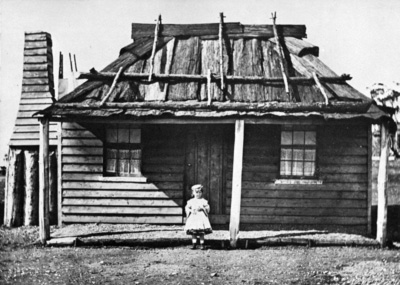
76 A smart little girl steals the scene in her full-skirted dress with wide sleeves, braid-trimmed. Her forward-tilted hat has a shallow crown with ribbon and flowers and she wears buttoned boots. (18224)
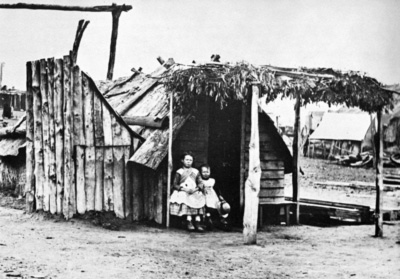
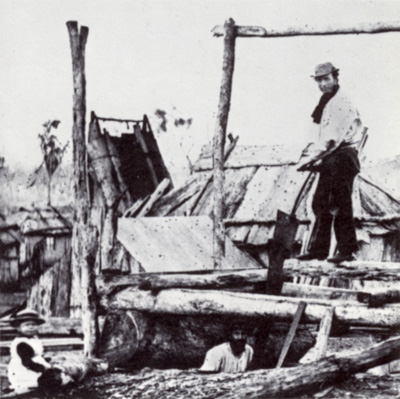
77/78 The daughters of the pit-sawyer pose sedately in a leafy shelter. The elder girl wears a plaid frock over which she has a white apron and a scarf hand-knitted in cable-stitch. Little sister is in a dark dress, also with white apron. 80th have heavy lace-up boots. Companion picture with some child identifies the father and his trade. (18171 / 18130). photo-web
footnote: check out the library's version to see how much of these two plates (18171 and 18130) have been editted for Gold & Silver
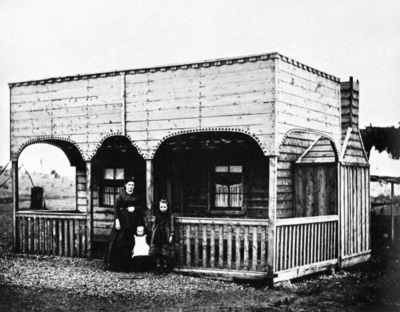
79 Surely reminiscent of his homeland is John Heins's lovingly-carpentered cottage (Before Street west). (18173)
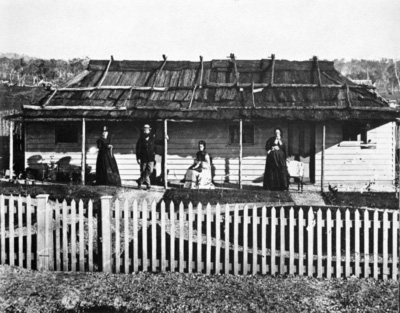
80 Just completed is this large well-constructed house with neat picket fence and newly planted garden. Of special interest are the elegantly-dressed women. (18204)
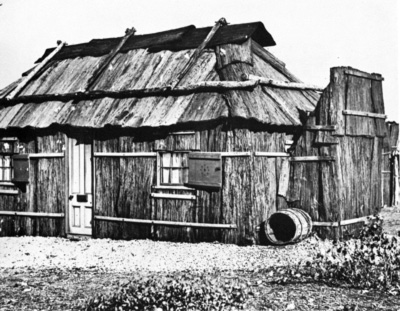
81 An admirable example of bush carpentry in stringy-bark, the latter held flat with heavy laths, with rarely seen wooden shutters. It appears to be the home of a professional man, Dr Wilson Ramsay, whose name can be read with high magnification. (18315)
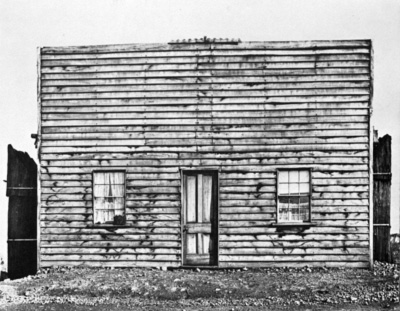
82 Very similar in feeling to the work of U.S. photographer Edward Weston is this photograph of a tall cottage front with twin chimneys, double pattern of wood-grain and water-stain, the starkness relieved by only minor decoration and flower cuttings on the sill. (18316)

83 Very fine study which need no description. (18225 )

84 Very fine study which need no description. ( 18193 ) - photo-web comment:
but click on the number to see the oiginal
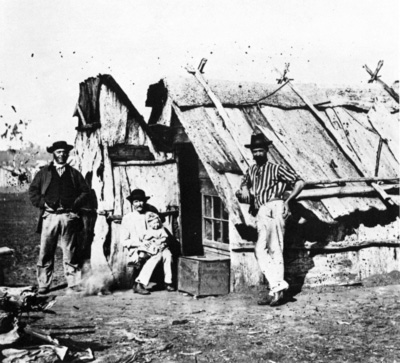
85 A pleasing grouping for an unusual quartette. The box stencil shows that it once contained 12 gross of Vestas (wax matches). (18370)
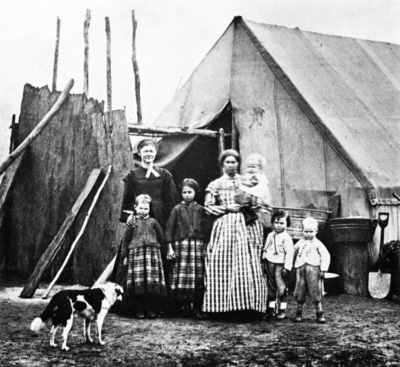
86 One of Henry Lawson's little homes of calico that dotted a11 the green’, with water cask and dipper on the right. (18181)
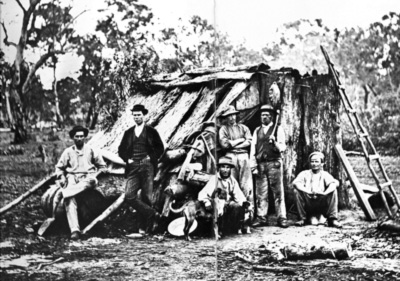
87 Perhaps the most impressive of the many syndicate groups. (18347) - no link available
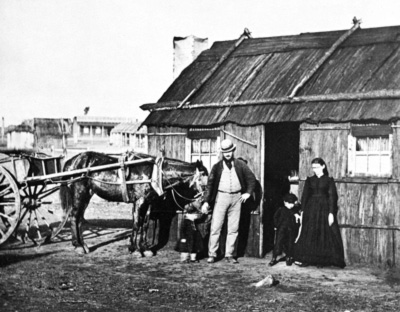
88 Another perfect example of a home of stringy-bark. In the distance can be seen the Golden Crown Hotel. (18227)
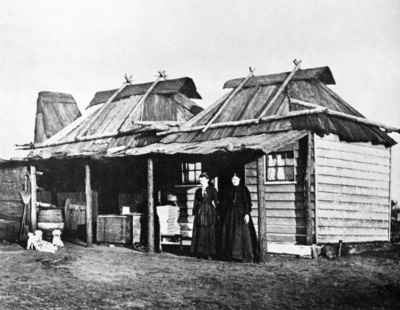
89 This house had separate cooking and sleeping quarters. 80th mother and daughter are in black, the mother with a chatelaine, the daughter with an apron trimmed with fine bobble braid.
Other items of interest, from left, two white poodles, water cask with washing-up dish, galvanism iron dipper and a rocking-chair set out to display an example of hand-weaving. (18199)
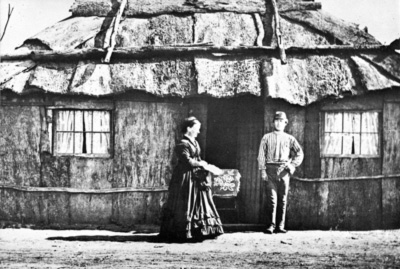
90 The woman holds a letter recently received, so perhaps the carte was specially taken to send to the person who wrote the letter so definitely featured. A piece of hand-worked embroidery is spread over the chair in the doorway. (18360)
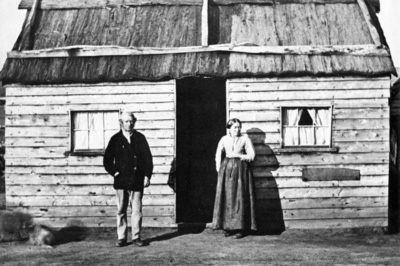
91 Strange partners. The woman was obviously not forewarned about the photographer's arrival, while the uniquely hatless man first wore his reefer jacket under very different circumstances. (18222)
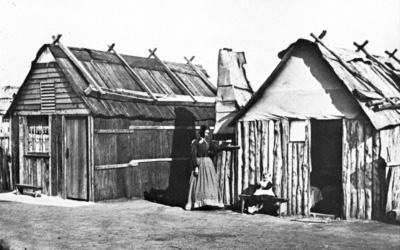
92 Two trim cottages in Chapel Street south, just beyond Camp Reserve. (18140) - no link available
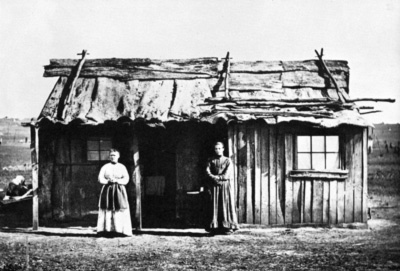
93 Walls of sawn timber, perhaps of-cuts, are not often seen in the photographs. Incidentally the photographer seems to have called on washing day. (18341)
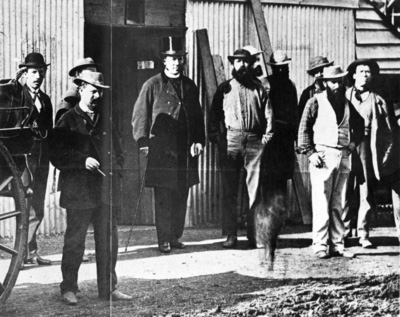
94 The Rt. Revd. S. E. Marsden, consecrated Bishop of Bathurst in 1869, grandson of the Revd. Samuel Marsden reaches Gulgong on a pastoral visit. He was a man of strong physique and intense conscientiousness, qualities which were often called upon during his continuous travels through his widening bishopric. (18258)
The library has this listed as: Father O'Donovan and men outside Blackman & Conway, auctioneers & commission agents, Gulgong - also note how much the above (18258) has been cropped.
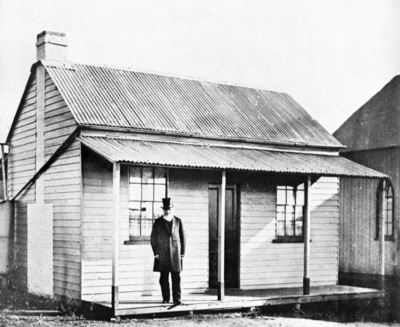
95 The Revd. J. Ornm visits the Methodist Church and the rectory. Completed in October 1871, both buildings are still standing in Medley Street near Little Belmore Street. (18106)
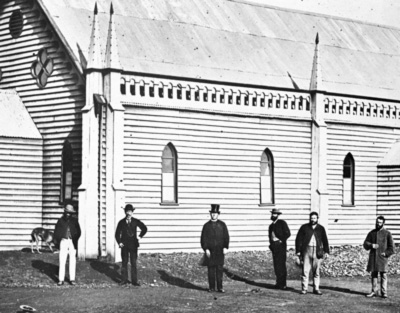
96 Father O'Donovan, Parish Priest of Mudgee, pays an early morning visit to his fine new wooden church, which had been speedily built in only two months by builder P. W. Kellaher of Mudgee.
The parishioner in the overcoat to the right has lost his hat in the wintry breeze, but it has been safely captured by the camera (bottom left corner). (18101)

97 After a shave at Green's the hairdresser, popular actor Tom Lacy strolls along Queen Street to the Prince of Wales Theatre, there to begin rehearsals for the new show to follow that currently running, which was Dion Boucicault's Irish comedy, Arrah-na-Pogue.
Other identified people besides Tom Lacy (with cane, against the tree) are the hairdresser S. Green, the theatre owner J. H. Cogdon, and Guigni the watchmaker.
Reconstruction of the street, Queen Street (east, south side) : side entrance to J. W. Foreman's A1l Nations Hotel, Piesenti's Cafë de France, G. Guigni (watches, jewellery and cigars), Gulgong Mercantile Advertiser (editorial office), Prince of Wales Theatre (box office and theatre entrance), unidentified tobacconist and colonial wine seller, S. Green (men's hairdresser), Mrs Green (women's hairdresser), T. McDonough (watchmaker), Michael Dillon (Dillon's Hotel), Blanchard (butcher), John Howard's Red Hill Hotel and Young's Store. (18353)
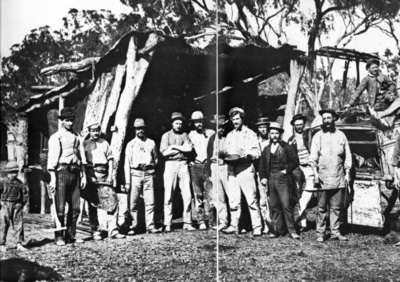
98 Clerk of Petty Sessions, Lester Stuart Donaldson- in the straw hat and pinstripes - has come for an official check on a claim which has bottomed on gold. On his right, the syndicate leader is proudly displaying a handful of small nuggets in the tail of his dish. Beside him are the other members of the syndicate and, on the far left, the smithies of the pointing forge.
By way of local colour, the photographer has included one of Jas. Leggatt's butchers providing instant service from one of their two meat carts, the only ones on the held. (18264)
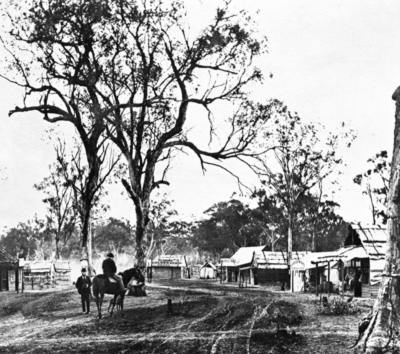
99 Beaufoy Merlin takes his caravan to Caledonian Lead to photograph the claims and the growing shopping centre'. Merlin is seen on horseback, while near him is the van driver holding a spare coated plate (1 dark-slide).
Premises along the right are an unknown butchery, Charles M. Ewen's general store, bark shop, Shamrock Hotel, vacant block with small white-washed hut, and W. A. Smith's Golden Age Hotel. (18401)
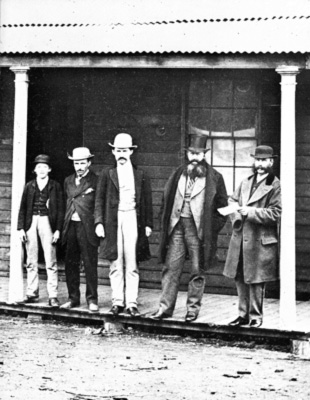
100. It is 7 September 1872 and the local Police Magistrate and Commissioner under the Goldfelds Act (centre) receives two official visitors from Sydney -they are the Under-secretary for Works (John Rae) in top hat and (far right) the Commissioner for Roads (Wm. Christopher Bennett). To the left are a clerk and his youthful strapper.
The name of the Police Magistrate is Thomas Alexander Browne, but, of course, he does not know that in sixteen years time his nom-do-plume of Rolf Boldrewood' will be well-known. (18103)
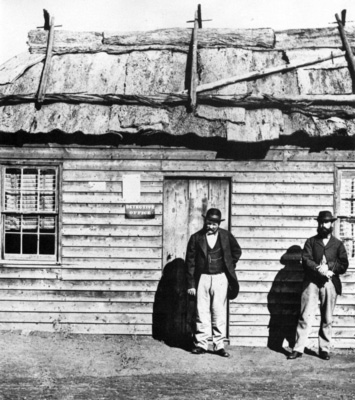
101 Detectives Powell and Hannan leave the Detective Office on an assignment. Amongst their duties was arson enquiry. (18246)
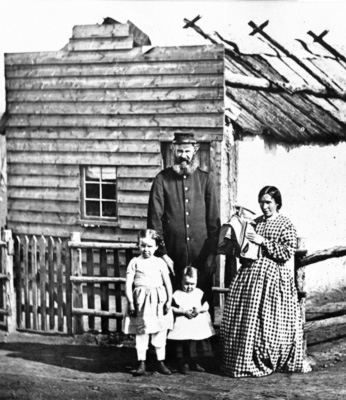
102 A Gulgong police officer with his young family and neat timber-fronted home. (18256)
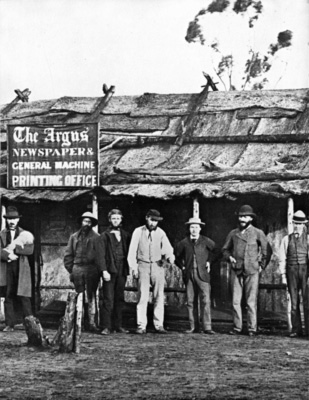
103 Gulgong Evening Argus editor, George Dunmore Lang (in white, news flash in hand) was the eldest son of John Dunmore Lang and died in Gulgong two years later. The two young men, names not known, had temporarily leased the paper from its owner, J. B. Stormer. (18137)
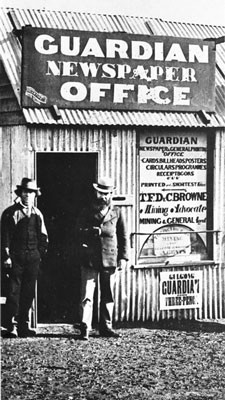
104 T. F. De Courcy Browne, editor of the Gulgong Guardian, assumes a Napoleonic stance as bests one who had dedicated himself to fighting for the rights of the miners in the face of unjust mining regulations and unfair interpretations thereof.
He received many writs for libel and this day may well be 11 September when he had just received a most contentious one- there is a paper peeping from his right-hand jacket pocket. The young man on the left margin is Henry Beal, his (runner', one of whose duties was to take the editorial material to Mudgee to be printed. (18133)
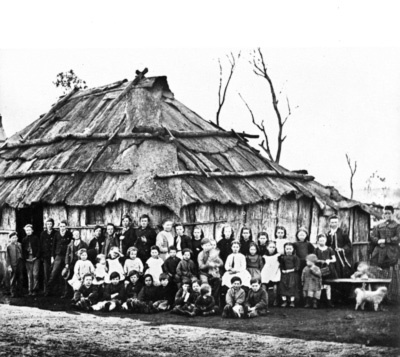
105 A school at an outfield, perhaps Black Lead, reminiscent of Henry Lawson's The Old Bark School. (18461)
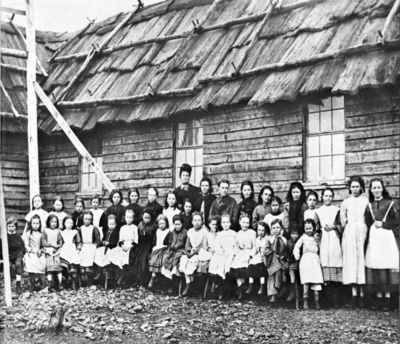
106 This was probably the principal girls' school in Gulgong. (18109)
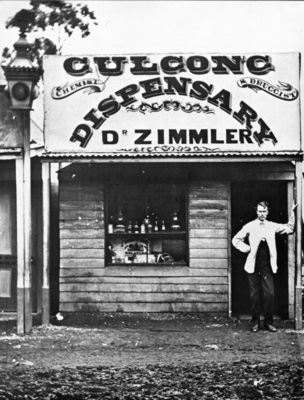
107 Dr Charles Zimmler's dispenser, young Mr White, late manager of Barnes's Mudgee Drug Store, steps out into Queen Street for a moment, to face the camera, and to provide the image that was later to be reproduced on every $10 note. (18289) [ note: this refers to the design of the $10 note in 1973]
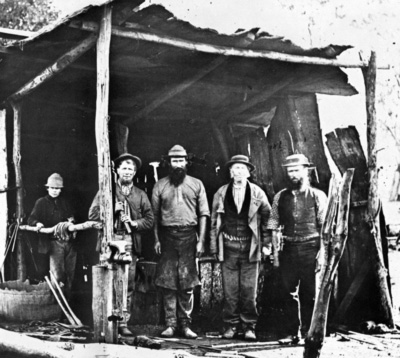
108 A smithy on one of the outfields - usually known as pointing forges since their principal task was the sharpening of mining picks and drills. In 'The Roaring Days', Henry Lawson tells us of ‘The pealing of the anvils as clear as little bells'.
Other regular forge jobs were the shoeing of whip horses and bending of iron handles for windlasses. (18381)
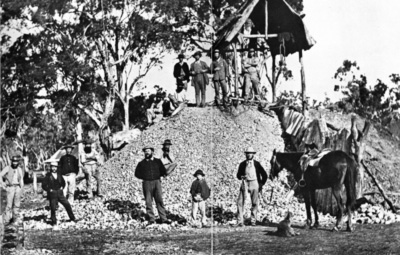
109 Every mining subject displays Merlin's individuality in posing, and here we have thirteen figures carefully posed, but the (story' has not been lost in the process. From the presence of the Clerk of Petty Sessions - Lester Stuart Donaldson, second from the loft - and from the tall <red flag' sapling (top left), we learn that the shaft has ‘bottomed on old' after fairly deep sinking.
The horseman is a mining surveyor who has come to check the depth of the shaft in accordance with current regulations. The shaft has a whip pole (to be seen just above the head of the topmost figure) while on his left is a bar of hanging iron with which to signal the movements of the hoist. (18274)
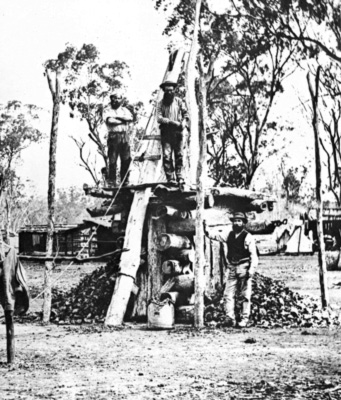
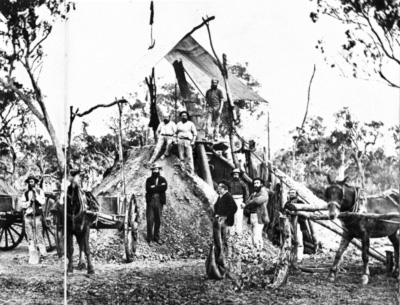
110/111 A pair of pictures selected to illustrate the use of the whip pole and whip horse. The smaller photograph shows a claim which has only just begun operations with the sturdy pig-pen construction around the mouth of the shaft clearly seen - this also takes the weight of the massive whip pole.
The larger illustration depicts the top of a deep shaft, another claim which has bottomed on gold' as can be observed from the flag. We are again reminded of Henry Lawson's (red flags flying over golden holes'.
The drays to the left are loading payable wash, mixed with rounded pebbles of white quartz, to be taken to the puddling machine. The pile to the right is bullock or valueless stone. For the recollections of an ‘Old Whim Horse' read Edward Dyson's verse in his Rhymes from the Mines. (18454 / 18426)
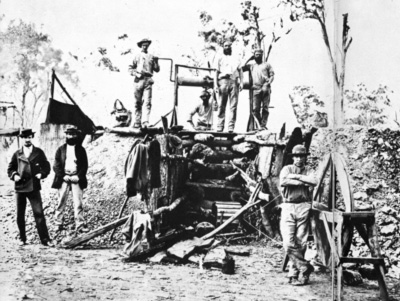
112 Despite the obvious depth of the shaft, the syndicate has been unable to afford the luxury of a whip horse (about £50) and so everything must go up and down by windlass and rawhide bucket both of which items are in evidence, as is a ventilation fan operated by manpower. (18412)
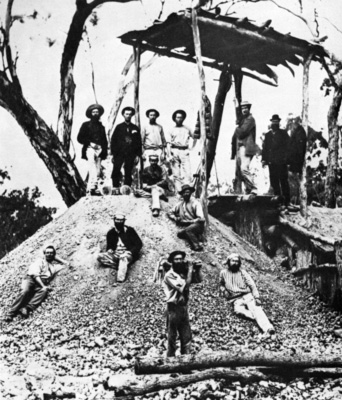
113 Selected for the novelty of the grouping - a whimsical contrast between formal and informal posing. (18352)
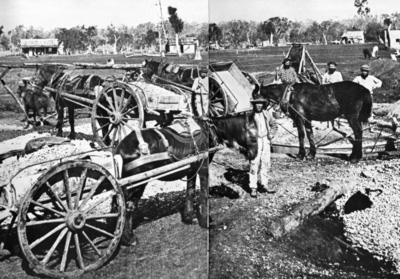
114 A fine record of the activity around a puddling machine, photographed from a slight camera elevation, perhaps from the floor of a dray. Puddling is called for when the gold is carried in heavy alluvial clay and also, in Gulgong, mixed with white quartz pebbles of a11 sizes.
The clay is watered down in a circular trough and loosened by a heavy rake device rotated by horse-power. Eventually the clay is loosened and the heavier gold sinks. The quartz pebbles are picked out by hand. Many of the pebbles remain to this day, while the actual trough has been reduced to a mere dimple hidden in the grass. (18198)
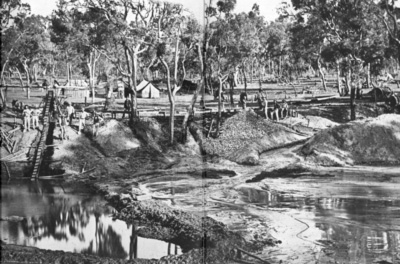
115 Every detail of the method employed to obtain the precious metal from a creek bed is displayed in this perfect photograph. A small area of the creek is dammed of and the mud drawn up by a whim - operated conveyor belt system. The gold is caught in the long horizontal tray probably by means of mercury on sacking. Pebbles and was are returned to the creek (right). (18263)
Trades and Professions
As mentioned by Anthony Trollope in 1871, ‘the inhabited part of the town consisted of two streets at right angles to each other'.
These streets were Queen Street, running from east to west and Herbert Street running north to Black Lead, but actually there was another originally known as Chapel Street parallel to Herbert Street.
Chapel Street was renamed Medley Street, after the much-respected Sub-inspector Medley, by the surveyors who also renamed Queen Street Mayne Street for no reason which has yet appeared.
In order that this section may be of use as a work of town reconstruction, the location of the various establishments has been included. A code of initials has been adopted : QE for the eastern block of Queen Street, QC fonr the central block of the same street, HN for the northern end of Herbert Street and so on.
It should be mentioned that the existing Mayne Street is called Queen Street since this was its name during 1872.
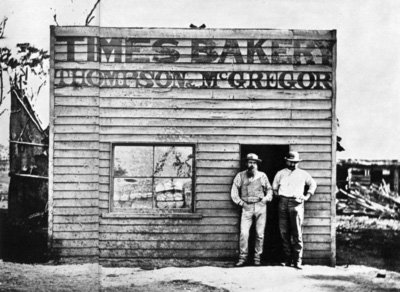
116 The Times Bakery (HN) will be recognised from its unaltered reproduction on the $10 note. (Most of the other Gulgong establishments included on the note have suffered from varying degrees of transposition, doubtless as a hindrance to possible forgery.)
The Bakery was originally at Black Lead but when the shopping area contracted northwards, the proprietors (Thompson and McGregor) moved to a new and substantial stone building (erected by Mark Smith) at the Bayly Street intersection.
In course of time, the (new' bakery, thanks to the local generosity and enthusiasm, became an integral part of the Gulgong Pioneers Museum and is annually inspected by more than ten thousand visitors. (18362)
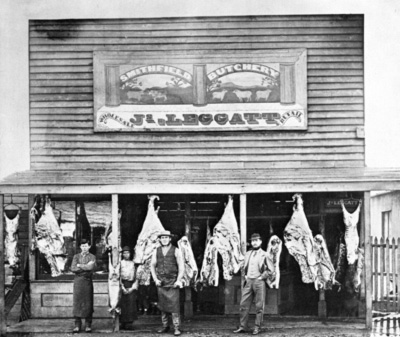
117 As an indication of the quality of this photograph, the original carte size and two degrees of enlargement are included, the larger one being about ten times. According to George Charles Johnson, who is responsible for recording so much concerning life in 'Golden Gulgong', James Leggatt (QC) was a smart Londoner who not only sold the best meat on the field but also energetically merchandised his butcher by press advertising and by the introduction of two butcher's carts.
He also introduced small goods in an extensive range: ‘On Saturday nights, he had tables set out in the street and displayed there on were joints, calves' heads, cows' heels, tongues, trotters, and small goods and these were quickly disposed of' Two of his typical prices were : prime 'steaks, 4d a 1b. and mutton by the sheep 2d. a 1b. (18252)
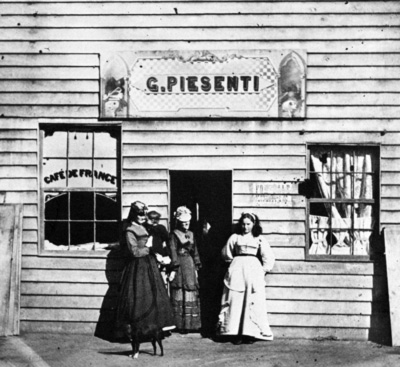
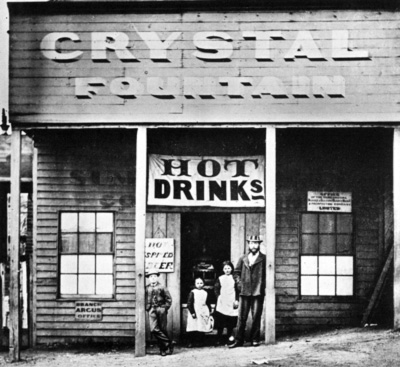
118 / 119 There were many restaurants for miners tired of catering for themselves, the best known of which was O'Neill's Scotch Pie and Coffee Shop (QC), but this particular negative is much damaged. G. Piesenti (QE) later obtained a Colonial Wine licence and altered his sign accordingly.
A. C. Cameron's Crystal Fountain (HS) specialized in cool drinks in slimmer and hot drinks in winter and, judging from the rotisserie device just visible through the open door, roasted meats and poultry were also available.
The Fountain advertised an intriguing range of beverages: ‘Gingerette, Pineapple, Curacao, Cloves, Shrub (rum with orange juice and spices), Rasberry Gingerene, Ginger Wine, Lemon, Maraschino, Chef Bundy, Peppermint, Bitters, Noyeau, Liqueurs'. There was also an Oyster Saloon (QC) - evidently well-packed oysters would keep for a fortnight. (18143 / 18170)
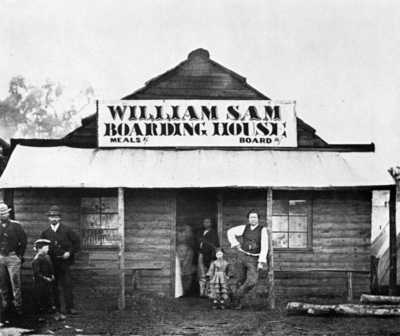
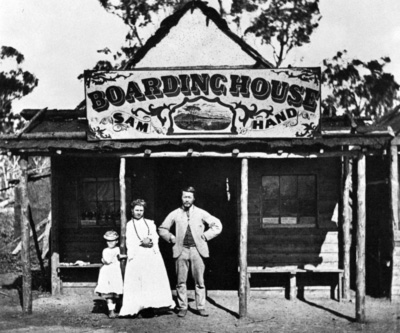
120 / 121 The prohibition on gold mining by Chinese lasted in N.S.W. only until 23 August 1864, but in the meantime they had been induced to undertake other means of livelihood. The ‘Board 16/-' is puzzling - originally (board' and ‘lodging' were separate charges. (18267 / 18332)
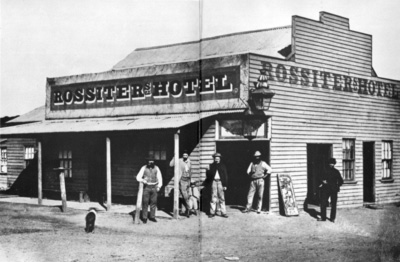
122 Harry Rossiter's Hotel (QW, MS) was one of the earliest hostelries. Features left to right: bird table with food, Harry Rossiter (with young son), customer with empty glass, and noticeboard for Thiodon's Kicking Belles- a vaudeville entertainment based on mechanical models. (18151)
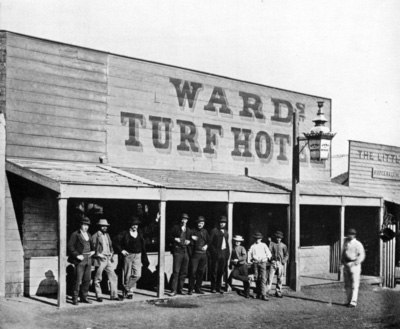
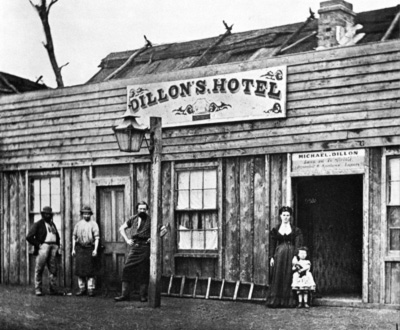
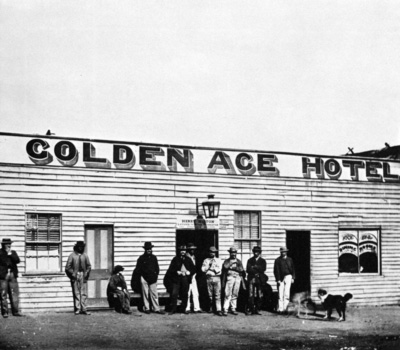
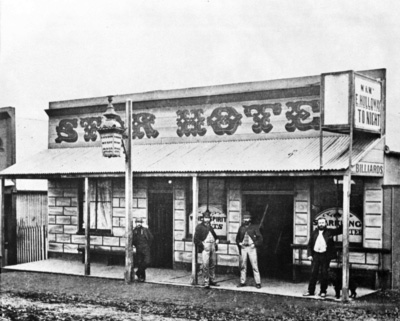
123/124/125/126 From a fairly large member of hotel pictures a few of the best have been selected. Ward's Turf Hotel (QC) -the premises were being remodelled at this time to include a theatre (left) which was to involve Ward in substantial fascial loss; Michael Dillon's Hotel (QE) ; Henry Hilton's Olden Age Hotel (QC) -a new licensee board covers the previous sign of Joseph Dietz who sold the hotel and moved to Canadian Lead; and Wm. Binder's Star Hotel (QC) which also included a billiard salon and a theatre-the London Music Hall where the Holloways were currently playing. With its imitation stone front and gay signboard, the Star regarded itself as (the handsomest hotel' on the field. (18148 / 18282 / 18251 / 18186)
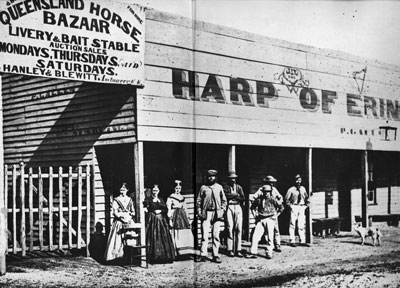
127 Patrick Gallen's Harp of Erin Hotel (QW). (18187)
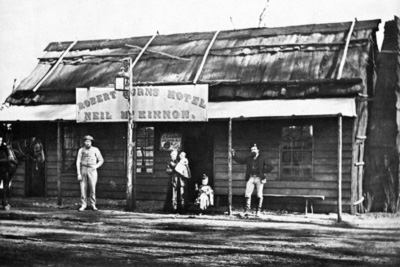
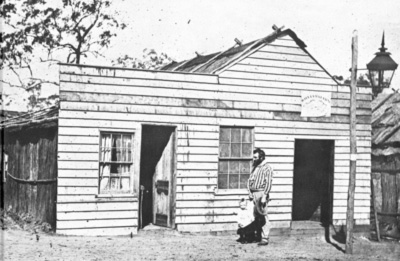
128 / 129 Two smaller hotels, probably at Black Lead and Home Rule, respectively. It will have been noticed that a1l hotels had lamps outside their premises. It was mandatory for the lamp to be kept burning from sunset to sunrise, a continuous worry for the licensee faced with the various hazards of poor kerosene, sudden storms and passing pranksters. (18357 / 18440)

130 The shopping centre at Home Rule. S. Bibb's Home Rule Hotel can be identified in the middle distance near the second tree. (18278)
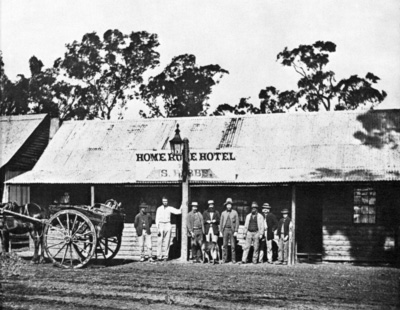
131 General view of Samuel Bibb's Home Rule Hotel. (18276)
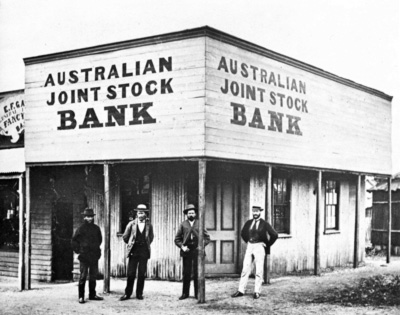
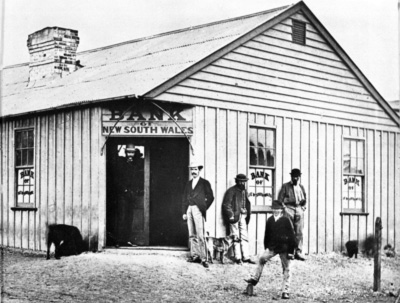
132/133 Two of the principal banks : The Australian Joint Stock Bank: (HS, Little Q) and the Bank of New South Wales (QC, HS). (18105 / 18099)
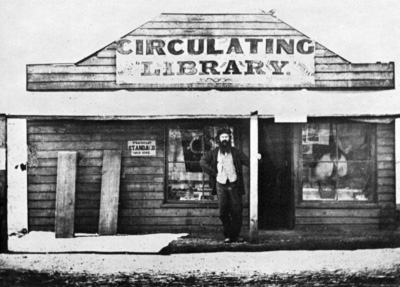
134 Donald's Circulating Library was probably in HN. (18359)
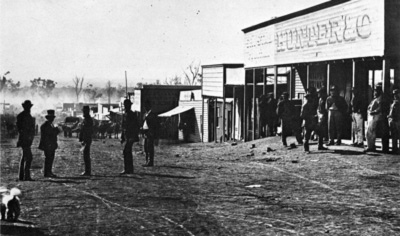
135 This illustration of the southern part of Herbert Street (east side) shows premises to the north of Queen Street. Reconstruction is as follows : Hunter and Co. (boots and shoes) ; Cameron's Crystal Fountain (this building later became S. Ferguson's Albion Hotel); Edward Purchase (chemist), Dr. W. H. B. Bennett (consulting rooms); Sippel Bros. (tobacconists, premises shown on $Io note) ; C. M. Dunn and E. Clarke (solicitors) ; R. W. Heard (saddler) ; Little Queen Street intersection; A. J. S. Rank; E. F. Garbode (fancy goods). (18241)
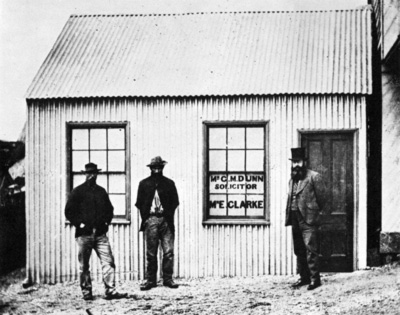
136 Solicitor C. M. Dunn (right) had his office in HS, one door up from Little Queen Street. C. M. Dunn was the resident solicitor, while E. Clarke came from Mudgee on Mondays, Tuesdays and Saturdays. (18169)
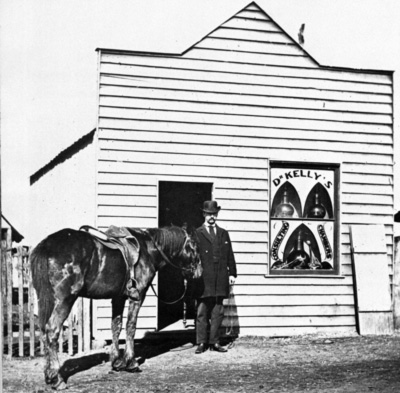
137 Dr Kelly outside his consulting rooms (QW). For be encouragement of possible patients, his window contains a display of prepared specimens of hands and other bony structures. (18307)

138 Dr J. D. Kinnear's premises (HC). (18158)
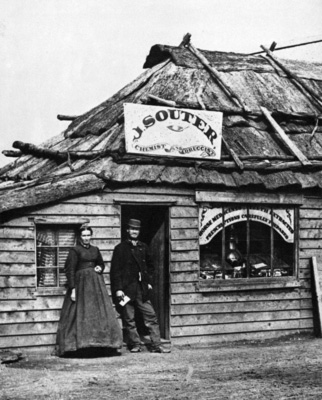
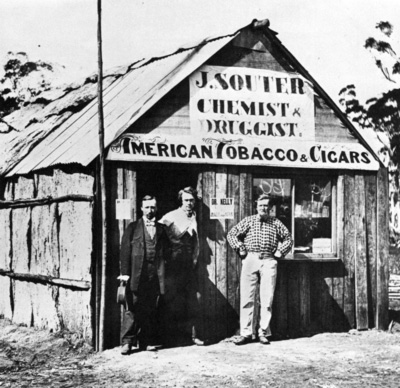
139/140 John Souter had two pharmacies - one in QW and the other at Home Rule. The Gulgong photograph shows Souter, prescription in hand, with his wife, and his window display with its amusing priorities.
The branch pharmacy at Home Rule includes (r. to 1.) the owner of the tobacco dept., in crimean flannel shirt and well-scrubbed moleskins, pharmacist and Dr O'Connor.
The poster states that Dr Kelly also attended (Every Tuesday and Friday, from I p.m. to 3 p.m.' (18301 / 18444)
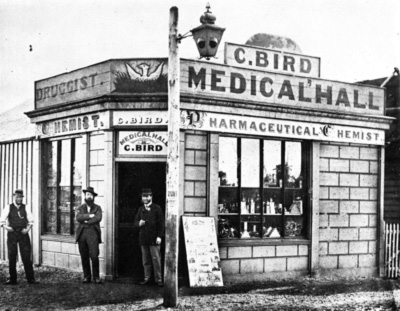
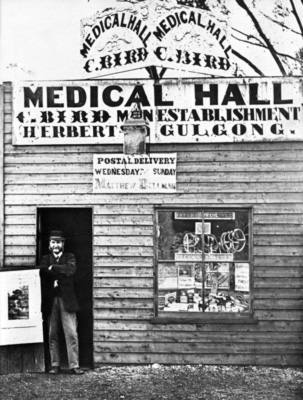
141/142 Charley Bird also had two pharmacies-one at the Belmore Street corner (HS), and the other at Home Rule. Charley Bird, very much a local identity, appears in both pictures. The Gulgong photograph includes the phoenix sign (popularly termed (sea bird'), board poster for various papers and an informative window display with a card for leeches.
The Home Rule pharmacy is notable for the sign for Matthew the Bellman (there were three in Gulgong), a poster for the Illustrated Sydney News, Friday, 23 August, and a fascinating display of goods and showcases.
The small horizontal white object in the bottom left comer of the window display was enlarged about forty times, and appeared to be a member of handbills for Tom Lacy's production of The Eighth Wonder of the World. (18160 / 18436)
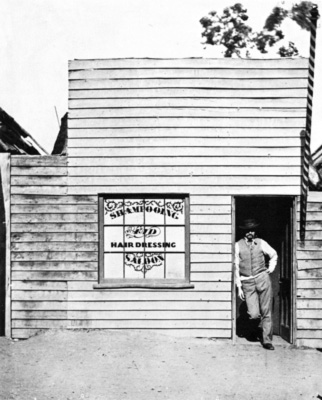
143 Also to be seen on the $10 note is barber T. B. Scurrah standing outside his Shampooing and Hairdressing Saloon (QC).
Writes Johnson: ‘Scurrah was a tall good-looking curly-headed man and a good hand at both hair-cutting and shaving . . . he could a1x sing a good song, his ‘Does yer want to buy a dorg’' and ‘My fader kept a brewery' being special favourites.' (18142)
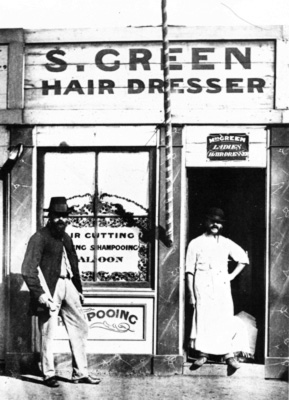
144 S. Green, Haircutting and Shampooing Saloon, also Mrs Green, Ladies Hairdresser (QE), (see plate 97). (18153)
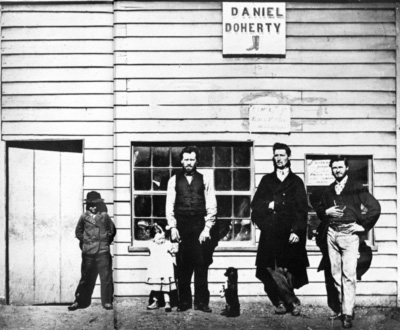
145 Daniel Doherty, leading bookmaker, is seen outside his new premises (QC), along with his young grand-daughter, well-trained dog and two sophisticated customers.
Johnson likened him, somewhat inaccurately, to the ever-busy mosquito who sings as he works. (18220)
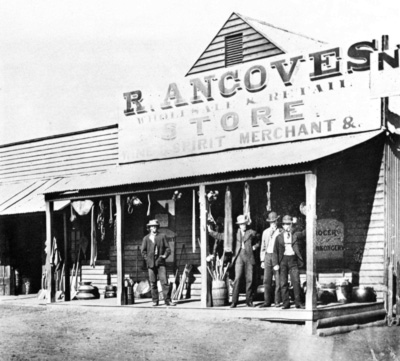

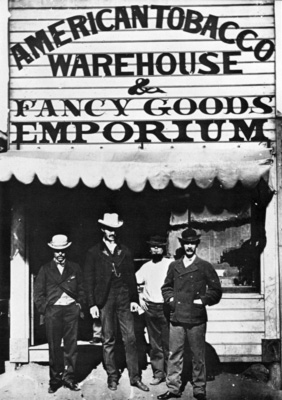
146/147/148 The everyday needs of the community were supplied by stores of extraordinary variety. R. Angove's (QC), was one of the first large general stores and Mrs Angove is the original of Mrs Mangove in Rolf Boldrewood's The Miner's Right. Frandsen's general store displays some of the lines in constant demand by the miners.
The four people photographed outside the American Tobacco Warehouse and Fancy Goods Emporium also appear on the $1o note where they are shown as if standing outside the Gulgong Dispensary. (18145 / 18439 / 18149)

149 A. Rodger's 'Little Wonder' store was the last establishment in QC, Chapel Street being shown on the right. (18152)
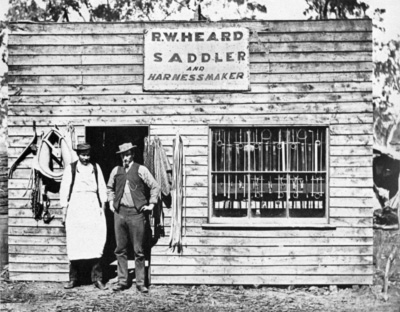
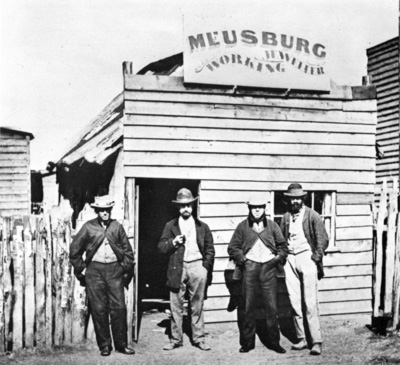
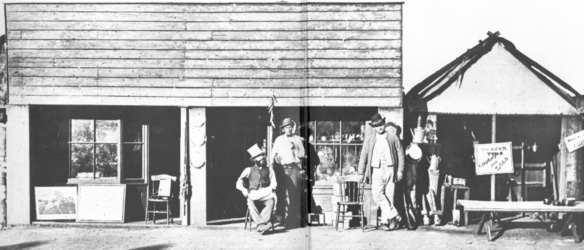
150 / 151 / 152 An appealing trio of businesses.
The new branch of R. W. Heard, Saddler and Harnessmaker at Home Rule showed his stock to perfection.
Meusberg, Working Goldsmith (QW) was a native of Switzerland. It was said of him when he died in the following June that ‘there is scarcely any successful miner or female fond of ornament in the colonies but has some memento of his handiwork'.
The third photograph shows a group of secondhand shops in lower Herbert Street. (18427 / 18188 / 18211)

153 A magnificent photograph of a truly magnificent establishment (QC), the proprietors being Abrade and Simeon Moses. (18141)
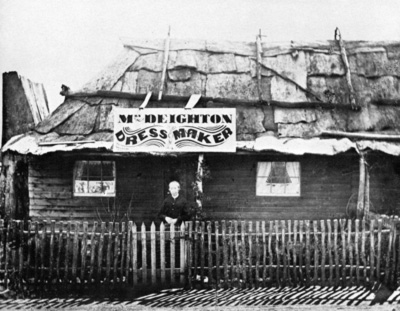
154 Mrs Jane Deighton's home was in Chapel Street just beyond the Camp Reserve. (18367)

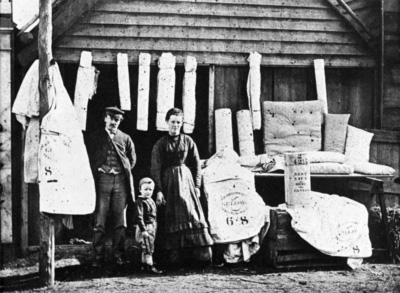
155 /156 The new Home Rule branch and the original workshop (QW) of W. H. Arrowsmith, tent and flag maker. He also made up mattresses and tarpaulins, the latter from the ‘best brown navy canvas'. (18441 / 18312)
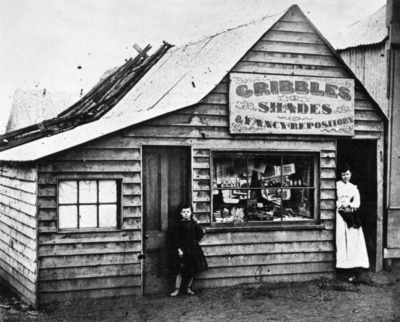
157 Gribbles' Shades & Fancy depositor (QW). (18310)
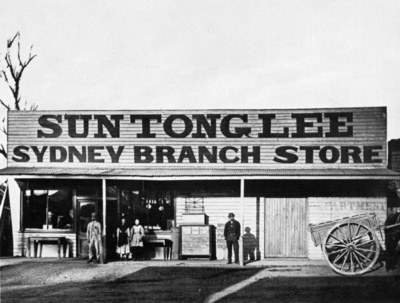
158 Despite a small fire, much of Sun Tong Lee's building in Herbert Street has survived to become be northern wing of the Gulgong Pioneers Museum. The enterprise is mentioned in Henry Lawson's story Christmas on the Goldfields: ‘Santa Claus is a Chinaman (Sun Tong Lee & Co., Storekeepers), with strange and delicious sweets that melted in our mouths, and rum toys and Chinese dolls for the children.' (18470)
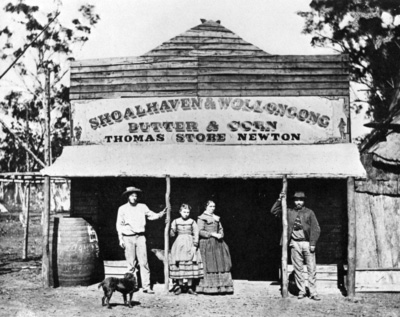
159 The butter which Thomas Newton sold really came from the Illawarra dairying censes. Packed in large casks, it was brought by coastal vessel to Sydney by train to the railhead at Macquarie Fields and thence by horse-team. (18435)
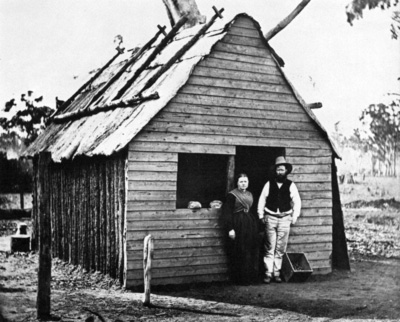
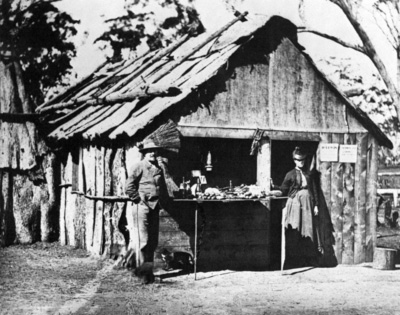

160 / 161 / 162 A baker and two corner stores on the outfields.
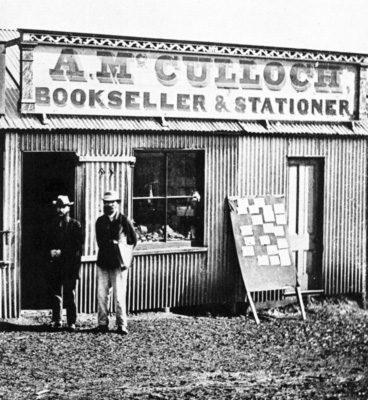
163 A. McCulloch, leading bookseller and stationer, second business on the left, HS. The proprietor is seen in the doorway and next to him, A. Matthews (bellman or ‘campanologist') who delivered papers and letters, the latter on an unsocial basis. The postal arrangements were very primitive and the subject of much criticism. Original negative included plate 104. (18133) << Note: make sure you click on number to see the full uncropped image
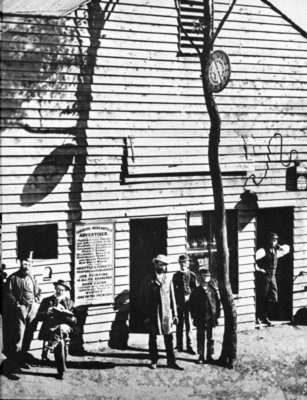
164 An informative exposure. The group, outside the Prince of Wales Theatre, (1. to r.) the partners who owned the Gulgong Mercantile Advertiser, Henry Tebbutt, J.P., and George Edwin Shettle, the publisher; John Hart Cogdon, in white hat, theatre manager and entertainer; far right, G. Guigni, watchmaker. The paper, originally a small free paper paid for by the advetisements, has only recently been absorbed by be Mudgee Guardian. (18354)
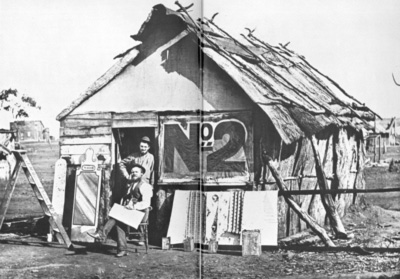
165 J. H. (Harry) Osborne, with his brother, was one of two signwriters and decorators in Gulgong, the other being W. Valentine. The camera has recorded much information: the workshop in a state of near collapse, samples of wallpaper and edging and a wooden tomb ‘stone’ with imitation marbling. The No. 2 is the number in the street, which is Chapel Street south, near the Camp Reserve. (18372)
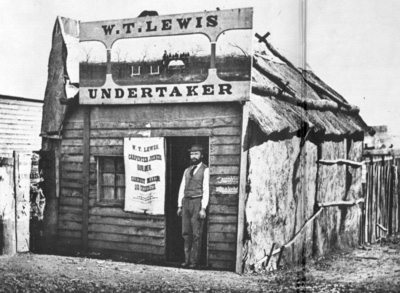
166 W. T. Lewis, cabinet maker and undertaker, was to be found in Herbert Street at the corner with Belmore Street, opposite Charley Bird's. The paintedsign shows a hearse with four horses, the whole suitably draped and plumed in the fashion of the day. (18168)
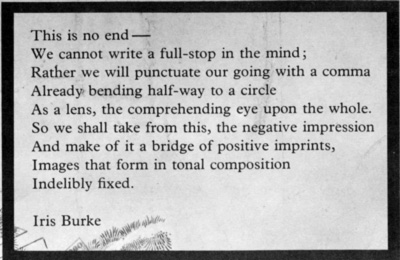

The book's front-piece - the front inside sleeve of the book
The book's rear-inside cover
use the links below to return to Gold and Silver
Introduction / Processes / Holtermann / Merlin / Bayliss / Iconography / Plates / Bibliography
>> see also A. P-R. 1953
Photo-web pages devoted the life and works of each of the main characters:
The text and notes to the plates: copyright © Keast Burke 1973
The original GOLD AND SILVER plates were reproduced from the Holtermann negatives, Mitchell Library Sydney.